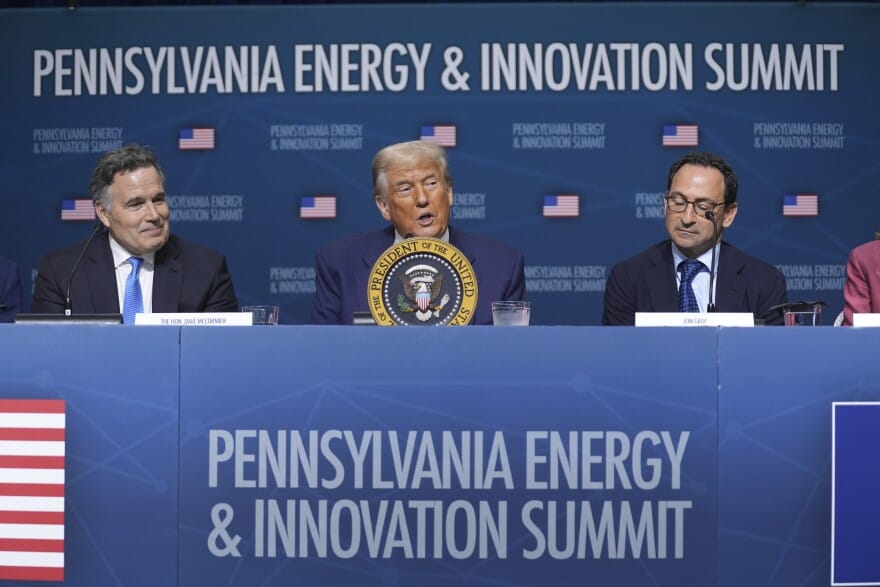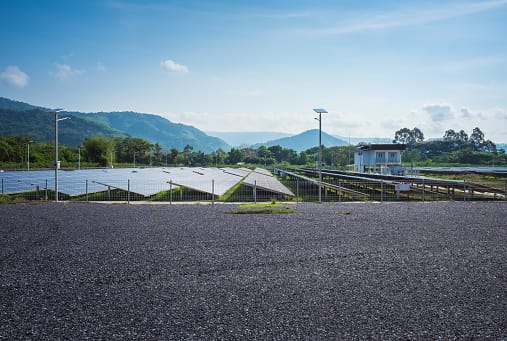- Grid Brief
- Posts
- Trump’s Grid Gamble // Governors Revolt at PJM // Schneider Goes Deep on Scope 3
Trump’s Grid Gamble // Governors Revolt at PJM // Schneider Goes Deep on Scope 3
America’s energy future is being rewritten in real time. This week, Donald Trump trades tax credits for gas turbines, nine governors threaten a mutiny against the nation’s largest grid operator, and Schneider Electric takes a shot at solving the supply chain emissions puzzle. Welcome to GridBrief—where AI eats voltage for breakfast, governors threaten secession (again), and the “energy transition” keeps stalling out somewhere in western Pennsylvania.
Trump’s $92 Billion Energy Blitz in Pennsylvania: Gas for AI, Not for Grid

President Donald Trump returned to the Rust Belt this week to announce a sweeping $92 billion suite of investments in Pennsylvania’s energy and artificial intelligence sectors. The announcement, made at the Pennsylvania Energy and Innovation Summit at Carnegie Mellon, signals the emergence of a new industrial strategy: align data center growth with domestic natural gas expansion.
The headlines from the summit include:
Blackstone + PPL Corp: A joint venture to build new combined-cycle natural gas plants specifically to power data centers. These will operate under long-term agreements that shield them from wholesale market volatility—essentially creating semi-regulated cash cows in a deregulated market.
FirstEnergy: Committed $28 billion to grid modernization across its service areas, with $15 billion earmarked for Pennsylvania. The funds will upgrade aging transmission and distribution infrastructure—paving the way for both reliability and political goodwill.
AmberSemi: A lesser-known but strategic player, the power conversion tech firm sees the moment as a pivot point. Its CEO described the summit as proof that efficiency—long a secondary concern—may finally be getting its due in high-level conversations.
But environmental groups weren’t celebrating. Evergreen Action called the move “a plan to double down on expensive fossil fuels,” accusing the administration of gutting clean energy incentives while spiking demand. They’re not wrong about the rising load: Data centers are projected to double their U.S. power demand by 2030. Pennsylvania, once synonymous with coal, is angling to become the engine room for the AI age—fueled by fracked gas.
The takeaway? Trump’s team is betting big on centralized load and firm generation. If you thought the energy debate was about wind turbines and solar panels, the new playbook says: think again.
Governors Declare Open Season on PJM Board
Nine governors representing the majority of PJM’s electric customers issued a scorching letter to the grid operator’s board this week, accusing it of leadership failures, stalled transmission progress, and price mismanagement.
They’re not just upset—they’re mobilizing.
Their letter calls PJM’s current state a “crisis of confidence,” citing skyrocketing capacity auction costs (up from $2.2B to $14.7B in a year), internal chaos, and mounting threats of state secession from the market. Two board members were recently ousted by PJM stakeholders, and CEO Manu Asthana is already planning his exit.
The governors’ demand: a formal role in selecting PJM’s next board members and a say in broader governance. That’s a first.
This isn’t idle politicking. States like New Jersey are actively considering legislation to leave PJM. Maryland and Pennsylvania have signaled openness to the idea. The grievances boil down to money and control. Rising bills, a clogged interconnection queue, and tone-deaf stakeholder processes have made it politically untenable for governors to defend the status quo.
PJM Chair David Mills offered a partial olive branch, inviting the governors to a July 23 meeting and defending the organization’s record. But some of the governors’ demands would require amending PJM’s operating agreement—a herculean political lift.
If this pressure campaign succeeds, it could usher in a new era of state-led energy governance. If it fails, it may fracture the most complex power market in the country. Either way, PJM’s monopoly on eastern grid planning is no longer secure.
Schneider Bets AI Can Decarbonize the Supply Chain

While government and utilities wrestle over infrastructure and reliability, Schneider Electric is quietly aiming to solve a different problem: the opaque, tangled mess of scope 3 emissions.
The French energy giant launched the Zeigo Hub, a digital platform that helps corporations measure and manage emissions across their entire supply chain. That means everything from tracking supplier emissions to nudging vendors toward greener operations.
What makes Zeigo different?
Agentic AI: Schneider’s term for its new AI-native tools that automate data scraping, simplify onboarding, and even send tailored invitations to suppliers.
Full Sponsor Coverage: Participating suppliers won’t pay to use the platform—the inviting corporation does. That removes the biggest barrier to entry.
Global Reporting Alignment: Zeigo is designed to align with the EU’s CSRD, the SEC’s (frozen but looming) disclosure rules, and other frameworks. It’s both a compliance tool and a corporate ESG signal.
This is Schneider’s second major digital launch in the decarb space in the last year. They’re not just chasing sustainability—they’re creating the operating system for it. With data center growth booming and scope 3 emissions under increasing scrutiny, expect others to follow.
Upgrade to Grid Brief Premium to get extra deep dives into energy issues all over the world.
Conversation Starters
Reason: Congress Cut $500 Billion in Energy Subsidies. That’s Good—and Proof Reform Is Possible
Veronique de Rugy makes the case that Trump’s cuts to green subsidies weren’t just justified—they were essential. Her argument: if your clean energy project can’t survive without taxpayer help, it doesn’t deserve to.C3 News: Clean Energy’s Future Remains Bright Even Without Energy Subsidies
Nick Loris argues that solar, nuclear, and natural gas will thrive even without IRA tax credits. Why? Because market demand, not government favoritism, is what actually builds resilient energy infrastructure.Robert Bryce: The Energy Transition is Fiction
Bryce pulls no punches in dismantling the fantasy of a global energy transition. According to the new Statistical Review of World Energy, hydrocarbons still provide 87% of the world’s energy—and alt-energy land-use battles aren’t going anywhere.
Good Bet, Bad Bet
Good Bet: Transmission Lawyers
If the PJM rebellion tells us anything, it’s that the future of U.S. energy isn’t just steel and electrons—it’s litigation. As more states push to exit markets or reshape governance, regulatory counsel will be the most valuable commodity in the room.
Bad Bet: The Energy Transition Narrative
It’s not dead, but it’s wheezing. Media headlines still pretend the world is mid-transition to a post-carbon grid. But the math doesn’t lie: fossil fuels still rule, land fights are choking wind and solar growth, and subsidy rollbacks are accelerating. Betting on vibes isn’t a strategy.
We rely on word of mouth to grow. If you're enjoying this, don't forget to forward Grid Brief to your friends and ask them to subscribe!